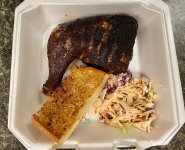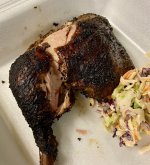You are using an out of date browser. It may not display this or other websites correctly.
You should upgrade or use an alternative browser.
You should upgrade or use an alternative browser.
Rubbery Chicken Skin
- Thread starter JohnY
- Start date
-
- Tags
- chicken skin rubbery
Cooked the chicken yesterday. Fought to keep the temp above 300 and failed. Chicken went in at 275, it climbed up to 310, but dropped back down after my flip to 260-270. I think the chicken dripping actually snuffed out the coals. I used 1.5 chimneys worth and will use more next time. Chicken was none the less delicious. Skin was edible and broken with teeth, but not crispy at all. No burnt flavor at all even though it looks dark.
Attachments
Some thoughts from cook…
Doing a dry brine overnight definitely allowed the rub to penetrate and imparted lots of flavor (and color) in the meat.
Sugar in rub was not an issue at low temps, but I would definitely omit it if given the choice.
Temperature needs to be above 300 as others recommended. I’d like to see 325-350 in my next test. Without any sugar in rub, 350-375 might be better.
I used hickory for wood. This isn’t something I would normally use, but I think given the short cooking time it gave a nice flavor without having to overwhelm with smoke.
Thanks again for all the input guys.
Doing a dry brine overnight definitely allowed the rub to penetrate and imparted lots of flavor (and color) in the meat.
Sugar in rub was not an issue at low temps, but I would definitely omit it if given the choice.
Temperature needs to be above 300 as others recommended. I’d like to see 325-350 in my next test. Without any sugar in rub, 350-375 might be better.
I used hickory for wood. This isn’t something I would normally use, but I think given the short cooking time it gave a nice flavor without having to overwhelm with smoke.
Thanks again for all the input guys.
Brett-EDH
TVWBB Olympian
suggestion, if you just rub salt on the chicken and then leave it exposed to air chill (on a rack in a tray) inside the fridge overnight, you'll see the skin gets quite shrivelled and mottled the next morning. this salt brine breaks down the skin and the salt penetrates the chicken meat as well. caution, do not oversalt the chicken as the bird will become too salty.Some thoughts from cook…
Doing a dry brine overnight definitely allowed the rub to penetrate and imparted lots of flavor (and color) in the meat.
Sugar in rub was not an issue at low temps, but I would definitely omit it if given the choice.
Temperature needs to be above 300 as others recommended. I’d like to see 325-350 in my next test. Without any sugar in rub, 350-375 might be better.
I used hickory for wood. This isn’t something I would normally use, but I think given the short cooking time it gave a nice flavor without having to overwhelm with smoke.
Thanks again for all the input guys.
for this method i have used both kosher and pickling salt as part of my experiments. i prefer the pickling salt because it has more "salt" flavor due to no additives in the salt but know that it is more salty in flavor then kosher salt.
i have found this method to help overcome rubbery skin due to the salt breaking the bird down. you can then add whatever seasonings you like onto your bird for grilling, just don't add salt or use a seasoning with salt in it.
you can also baste with melted butter when you cook this brined bird as it will add substantial flavor and the butter's fat will aid in browning during the cook.
Jim C in Denver
TVWBB Wizard
There's a long list of anti-rubber chicken skin measures. You probably don't need to use all of them, but you should be using some of them:
1. Blot skin dry with paper towels on both sides multiple times.
2. Dry brine with salt.
3. Add baking powder to #2.
4. 12-24 hours in the fridge uncovered on a wire rack.
5. Puncture skin with meat tenderizer needles to let the fat flow out while cooking.
6. Cook at high heat. For the whole cook time. Or just at the end to crisp. Vortex, broiler, etc. No water. No water pan. No diffuser plate. Lots of lit charcoal. Crack the door. Crack the lid.
7. Brush pieces with oil or butter to aid browning.
1. Blot skin dry with paper towels on both sides multiple times.
2. Dry brine with salt.
3. Add baking powder to #2.
4. 12-24 hours in the fridge uncovered on a wire rack.
5. Puncture skin with meat tenderizer needles to let the fat flow out while cooking.
6. Cook at high heat. For the whole cook time. Or just at the end to crisp. Vortex, broiler, etc. No water. No water pan. No diffuser plate. Lots of lit charcoal. Crack the door. Crack the lid.
7. Brush pieces with oil or butter to aid browning.
Tim Snyder
TVWBB Super Fan
You can't low and slow chicken skin. You're just making leather.
The only difference between kosher salt and pickling salt is the size of the salt grain. Both are pure salt, no anti-caking agents, no iodine, just salt. There may be taste differences between brands if they come from different sources, but Morton kosher should taste exactly like Morton pickling salt. I'd think it more likely that the smaller grain size of pickling salt lets you get a more even coating. It probably dissolves faster too, allowing more time for the salt to work its way into the meat.i prefer the pickling salt because it has more "salt" flavor due to no additives in the salt but know that it is more salty in flavor then kosher salt.
Brett-EDH
TVWBB Olympian
From Morton's boxes for both Kosher salt and Pickling Salt:
Kosher salt - serving size 1/4 tsp, 1.2g, sodium 480mg - https://www.amazon.com/dp/B00FS1X5Q2/?tag=tvwb-20
Canning/Pickling salt - serving size 1/4 tsp, 1.5g, sodium 590mg - https://www.amazon.com/dp/B003U4TRN4/?tag=tvwb-20
I am not arguing here. Pickling salt weighs more per tsp due to its size, thus is has a more "salty" flavor. Example, when cooking/prepping food with either salt, one needs to know the differences in how much salt is being applied to the recipe as 1/4 tsp doesn't equal 1/4 tsp to each respective salt.
When I brine raw salmon for lox and then cold smoking, I reduce my salt amounts when using Pickling salt by almost 1/3. I find pickling salt penetrates salmon more quickly and imparts the taste profile I am seeking when trying to be in the dry brine for 24 hours or less.
And the same goes for when I dry rub a chicken; I want to be dry brined for <12 hours using pickling salt and I use less salt because it is "saltier" than Kosher salt.
Let's not even engage in Himalayan salt. That's another entirely different problem.
Kosher salt - serving size 1/4 tsp, 1.2g, sodium 480mg - https://www.amazon.com/dp/B00FS1X5Q2/?tag=tvwb-20
Canning/Pickling salt - serving size 1/4 tsp, 1.5g, sodium 590mg - https://www.amazon.com/dp/B003U4TRN4/?tag=tvwb-20
I am not arguing here. Pickling salt weighs more per tsp due to its size, thus is has a more "salty" flavor. Example, when cooking/prepping food with either salt, one needs to know the differences in how much salt is being applied to the recipe as 1/4 tsp doesn't equal 1/4 tsp to each respective salt.
When I brine raw salmon for lox and then cold smoking, I reduce my salt amounts when using Pickling salt by almost 1/3. I find pickling salt penetrates salmon more quickly and imparts the taste profile I am seeking when trying to be in the dry brine for 24 hours or less.
And the same goes for when I dry rub a chicken; I want to be dry brined for <12 hours using pickling salt and I use less salt because it is "saltier" than Kosher salt.
Let's not even engage in Himalayan salt. That's another entirely different problem.
I have no disagreement at all about the differences in weight per volume among the various forms of salt. This is demonstrably true and something any good cook should be well aware of. There is even a significant difference between Morton kosher salt and Diamond Crystal kosher salt. If you care at all about consistent use of salt across all forms, you weigh the salt, not measure it by volume, or at least be aware of the weight/volume differences and adjust the volume. This is exactly why you need to carefully weigh the ingredients when dry curing meats.I am not arguing here. Pickling salt weighs more per tsp due to its size, thus is has a more "salty" flavor. Example, when cooking/prepping food with either salt, one needs to know the differences in how much salt is being applied to the recipe as 1/4 tsp doesn't equal 1/4 tsp to each respective salt.
I do, however, disagree with the notion that one form of salt is "saltier" than another. One gram of kosher salt mixed with one liter of distilled water will create a 0.1% salt solution. One gram of pickling salt mixed with one liter of distilled water will also create a 0.1% salt solution. If one form were "saltier" than the other this would not be the case.
Brett-EDH
TVWBB Olympian
You and I fully agree. The issue is just about every recipe published here calls for Tbsp or Tsp. So the unsuspecting end used hasn't a real clue what that means. My point was, specifically, when using different salts, know that all salts don't apply equally. The average person doesn't weigh their salt, they just apply it.I have no disagreement at all about the differences in weight per volume among the various forms of salt. This is demonstrably true and something any good cook should be well aware of. There is even a significant difference between Morton kosher salt and Diamond Crystal kosher salt. If you care at all about consistent use of salt across all forms, you weigh the salt, not measure it by volume, or at least be aware of the weight/volume differences and adjust the volume. This is exactly why you need to carefully weigh the ingredients when dry curing meats.
I should have made more clear in this statement, "for this method i have used both kosher and pickling salt as part of my experiments. i prefer the pickling salt because it has more "salt" flavor due to no additives in the salt but know that it is more salty in flavor then kosher salt," that the salt volume applied is different between kosher salt, different brands of kosher salt and pickling salt.
If anyone wants to dig deeper on salt, here's a good writeup discussing the difference between brands and styles. https://www.chowhound.com/food-news/47641/thats-so-salty-its-not-salty-enough/
Either way, take all of this with a grain of salt and know that the different salts have different weights if you're measuring Tsp and Tbsp which in the end effect a recipe or brine.
Last edited:
We'll have to agree to disagree concerning the accuracy of your description of pickling salt as being "saltier" than kosher salt. On everything else salt we seem to be in complete agreement. The different forms have different densities and different dissolving properties due to grain size. If you want the salt level in your dish to come out right, you need to be aware of these differences if using a different form than mentioned in the recipe. Thank goodness table salt appears to be consistent across brands.
EricV.
TVWBB Guru
When using the firedial, did you hang the the chicken vertically or was it lying horizontally on the grill grate?Cooked the chicken yesterday. Fought to keep the temp above 300 and failed. Chicken went in at 275, it climbed up to 310, but dropped back down after my flip to 260-270. I think the chicken dripping actually snuffed out the coals. I used 1.5 chimneys worth and will use more next time. Chicken was none the less delicious. Skin was edible and broken with teeth, but not crispy at all. No burnt flavor at all even though it looks dark.
Mark Evenson
TVWBB Wizard
Chris, just what I was looking for. Wanted to smoke a rack of ribs at the same time, better use another smoker.It's hard to get decent skin in the WSM when cooking at low & slow temps. Skin will always be rubbery.
You have to cook hot, hot, hot. That will give you bite-through skin, if not crispy skin. To crisp, you need to move the cooking grate directly over the charcoal ring at the end of the cook.
Try this for better results:

Hot & Fast Chicken - The Virtual Weber Bullet
Hot & Fast Chicken: Tender, well-rendered chicken skin worth eating is achieved using a high-temp smoke-roasting method in the Weber Smokey Mountain Cooker.www.virtualweberbullet.com
Thanks.


